Today, everybody is familiar with electricity. Let's say, almost everybody
uses electricity as a ready-for-use energy that is provided in a clean way.
This is the result of long research and engineering work which can be traced
back for centuries. The first generators of electricity were not electrodynamic
as today's machines, but they were based on electrostatic principles. Long
before electrodynamic generators were invented, electrostatic machines and
devices had their place in science. Due to their principle of operation,
electrostatic generators produce high voltage, but low currents. The output
is always a unipolar static voltage. Depending from the used materials, it
may be positve or negative.
Friction is the key of the operation! Although most mechanical energy needed
to power an electrostatic generator is converted into heat, a fraction of
the work (not a fraction of friction - got the point?) is used to generate
electric potential by splitting charges.
The Beginnings
In ancient greece, the amber was known to attract little objects after being
rubbed with cloth or fur. From the Greek expression elektron, the modern
term electrics is directly derived. In 1600, William Gilbert
(1544-1603) coined the expression electrica in his famous book
De Magnete.
In ancient Greece, there was no effort to mechanize the rubbing of a piece
of amber in order to get a continous effect. Although light could be observed
in the dark, nobody made a connection between this and the lightning which
was regarded as Zeus' weapon. The knowledge about this type of electricity
remained almost unchanged until the beginning of the seventeenth century.
Several antique authors like Pliny the elder or Renaissance men like Giovanni
Battista della Porta describe the effect but without drawing further conclusions.
The Sulphur Ball
 Otto
von Guericke (1602-1686) who became famous for his Magdeburg vacuum experiments
invented a first simple electrostatic generator. It was made of a sulphur
ball which rotated in a wooden cradle. The ball itself was rubbed by hand.
As the principles of electric conduction had not been discovered yet,
von Guericke transported the charged sulphur ball to the place where
the electric experiment should happen.
Otto
von Guericke (1602-1686) who became famous for his Magdeburg vacuum experiments
invented a first simple electrostatic generator. It was made of a sulphur
ball which rotated in a wooden cradle. The ball itself was rubbed by hand.
As the principles of electric conduction had not been discovered yet,
von Guericke transported the charged sulphur ball to the place where
the electric experiment should happen.
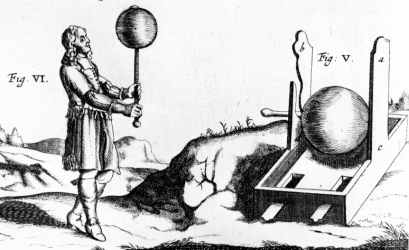
von Guericke's first electrostatic generator around 1660
Guericke made the ball by pouring molten sulphur into a hollow glass sphere.
After the sulphur was cold, the glass hull was smashed and removed. Some
day, a researcher found out that the empty glass sphere itself provided the
same results.
A Baroque Gas Discharging Lamp
In 1730 scientific research has discovered the principles of electric conduction.
An inspiriation for electric research came from an area which at the first
glance had absoluteley nothing to contribute: the mercury barometric device
invented by Evangelista Torricelli. If the mercury-filled tube was shaken
and the evacuated portion of the tube was observed in the dark, a light emission
could be seen. William Hauksbee, both inventive and inquisitive, designed
a rotor to rub a small disk of amber in a vacuum chamber. When the chamber
contained some mercury vapour, it lit up! This was the first mercury gas
discharge lamp! The engravings show surprising similarities to today's lightning
spheres.
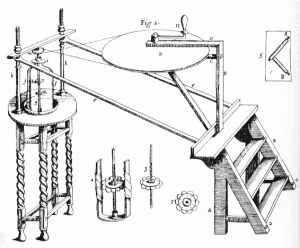
Hauksbee's amber rotor
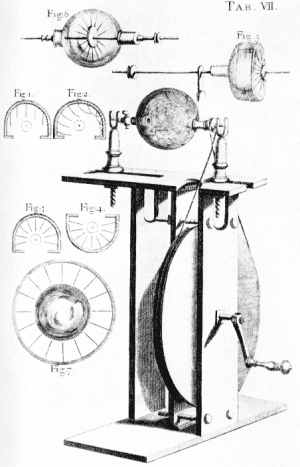
Hauksbee's setup to demonstrate
light effects caused by static electricity.
The Beer Glass Generator
Glass proved to be an ideal material for an electrostatic generator. It was
cheaper than sulphur and could easily be shaped to disks or cylinders. An
ordinary beer glass turned out to be a good isolating rotor in Winkler's
electrostatic machine.
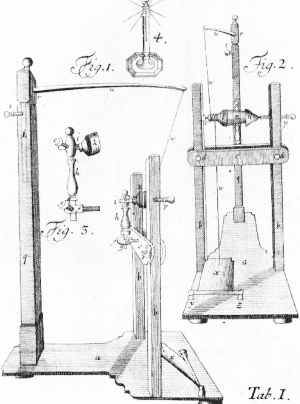
An electrostatic machine invented by
Johann Heinrich Winkler (1703-1770)
Machines like these were not only made for scientific research, but a preferred
toy for amusement. In the 18th century, everybody wanted to experience the
electric shock. Experiments like the "electric kiss" were a salon pastime.
Although the French Abbé Nollet demonstrated in 1745 that little animals
like birds and fish were killed instantaneuosly by the discharge of a Leyden
jar, nobody was aware of the latent dangers of this type of experiments.

The electric kiss provided a very special thrill
Soon after the effects of electrostatic discharge were found, researchers
and charlatans started to cure diseases with electric shocks. Here we find
parallels to the "Mesmerists" who claimed to use magnetic powers for therapy.
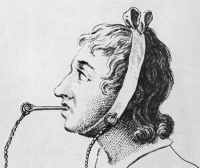
Toothache therapy around 1750
Being ill at that time was no fun!
The Leyden Jar
In 1745, the so-called Leyden Jar (or Leyden Bottle) was invented
by Ewald Jürgen von Kleist (1700-1748). Kleist searched for a way to
store electric energy and had the idea to fill it into a bottle! The bottle
contained water or mercury and was placed onto a metal surface with ground
connection. No wonder: the device worked, but not because of the fact that
electricity could be filled into bottles.One year after Kleist, the physicist
Cunnaeus in Leyden/the Netherlands independently invented this bottle again.
Thus the term Leyden Jar became more familiar, although in
Germany, this device sometimes also was called Kleist's bottle.
An intense research work began to find out which liquid is the most suitable.
A few years later, researchers had learned that water is not necessary, but
a metal hull inside and outside the jar was sufficient for storing electrostatic
energy. Thus the first capacitors were born.
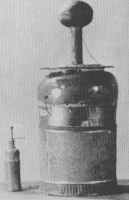 |
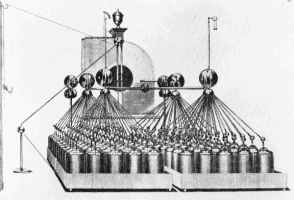 |
| Early Leyden jars |
An advanced electrostatic battery in 1795 |
Frequently, several jars were connected in order to multiply the charge.
Experimenting with this type of capacitors started to become pretty dangerous.
In 1783, while trying to charge a battery during a thunderstorm, Prof. Richmann
was killed by unintendedly getting too close to a conductor with his head.
He is the first known victim of high voltage experiments in the history of
physics. Benjamin Franklin had a good deal of luck not to win this honour
when performing his kite experiments.
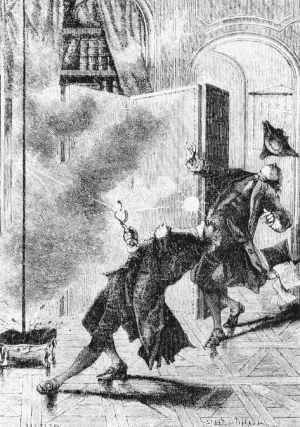 |
St. Petersburg, 6 August 1783. Prof. Richman and his assistant being
struck by lightning while charging capacitors. The assistant escaped almost
unharmed, whereas Richman was dead immediately. The pathologic analysis revealed
that "he only had a small hole in his forehead, a burnt left shoe and a blue
spot at his foot. [...] the brain being ok, the front part of the lung sane,
but the rear being brown and black of blood." The conclusion was that the
electric discharge had taken its way through Richmann's body. The scientific
community was shocked. |
The Disk Rotor
Generators based on disks were invented around 1800 by Winter. Their
characteristic construction element is a mercury-prepared leather cushion
that covers approximately one forth of the surface area. The leather cushion
replaced the experimentor's hand and gave a more continous result. In 1799,
first experiments of electrolysis by electrostatic energy were made. It turned
out that the recently invented chemical elements caused same or better effect
than many thousand electric discharges of a Leyden bottle battery. Experiments
like these helped to shape the understanding of electric energy.

An early disk generator by Winter
The Advanced Rotor
Inventors found out that it is a good idea to laminate metal or cardboard
sheets onto the isolating disks of electrostatic generators.
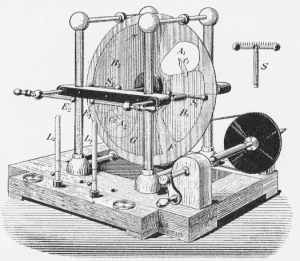
The so-called influence machine by Holtz, 1865
Disks for advanced generators of this type were made of glass, shellac and
ebonite (hard rubber). Especially hard rubber turned out to be a very suitable
material as it did not get damaged so easily than glass or shellac.
The Wimshurst Machine
Wimshurst machines are the end point of the long development of electrostatic
disk machines. They caused very good results and were frequently used to
power X-ray tubes. The characteristic construction element of these machines
are disks which are laminated with radially arranged metal sheets. The advantage
of disks is that they can be stacked onto one axle in order to multiply the
effect.
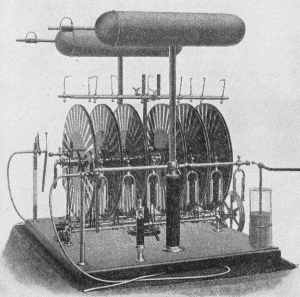
A Wimshurst machine around 1905.
The end point of a long development.
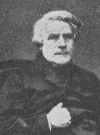 The invention of the electomagnetic inductor by Ruhmkorff in
1857 began to make the electrostatic disk machines obsolete. Today, both
devices only serve as useful demonstration objects in physics lessons to
show how electric charges accumulate. For technical applications, high voltages
can be easier generated by electronic and electromagnetic
methods.
The invention of the electomagnetic inductor by Ruhmkorff in
1857 began to make the electrostatic disk machines obsolete. Today, both
devices only serve as useful demonstration objects in physics lessons to
show how electric charges accumulate. For technical applications, high voltages
can be easier generated by electronic and electromagnetic
methods.

A Ruhmkorff inductor to power an X-ray tube (1910)
The Van-DeGraaff Generator
The principle of this machine is to transport voltage by the aid of a tape
made of isolating flexible material e.g. rubber. Early in the development
of machinery, it was observed that mechanical transmission belts gave reason
for unintended high voltage production, which harmed persons or buildings
by igniting parts of a workshop. The same effect caused by transporting the
highly inflammable celluloid films inside the projector was the reason for
more than one cinema perishing in fire.
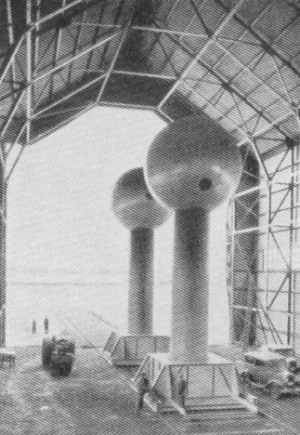
A 5 Megavolt Van-deGraaff generator
The principle is based on an isolating endless tape which transports an electric
charge to a conductor. Although the device can be operated without an additional
electric power source, normally a DC high voltage is applied to the tape,
thus considerably increasing the output voltage. Van DeGraaff generators
are still in use in particle accellerator labs. The largest machines produce
up to 10 million Volts.
The Steam Electrostatic Generator
Wet steam which is pressed through a nozzle causes electric chargement. This
was the origin of the idea to construct an electrostatic generator based
on steam. Although these machines caused good results, they were difficult
to maintain. As they also were expensive, comparatively few were built and
have survived in museum collections.
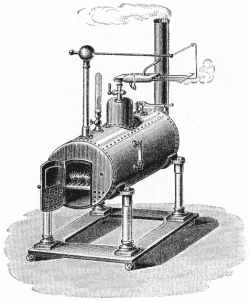
A steam electrostatic generator
Conclusion
Electrostatic generators have their place in the history of science. They
accompanied the way to understand electricity. However, their efficiency
is poor, compared to the mechanical effort which is needed to produce electrical
energy. In this context, I'd like to seriously warn all would-be inventors
of electrostatic PMMs based on disk rotors or on the Van deGraaf principle.
Machines of this type are no toy and even small devices can be dangerous
if carelessly handled. As a rule of thumb, a charged Leyden jar of 1/2 liter
(=1/8 gallon) volume can endanger your life!
 Otto
von Guericke (1602-1686) who became famous for his Magdeburg vacuum experiments
invented a first simple electrostatic generator. It was made of a sulphur
ball which rotated in a wooden cradle. The ball itself was rubbed by hand.
As the principles of electric conduction had not been discovered yet,
von Guericke transported the charged sulphur ball to the place where
the electric experiment should happen.
Otto
von Guericke (1602-1686) who became famous for his Magdeburg vacuum experiments
invented a first simple electrostatic generator. It was made of a sulphur
ball which rotated in a wooden cradle. The ball itself was rubbed by hand.
As the principles of electric conduction had not been discovered yet,
von Guericke transported the charged sulphur ball to the place where
the electric experiment should happen.











 The invention of the electomagnetic inductor by Ruhmkorff in
1857 began to make the electrostatic disk machines obsolete. Today, both
devices only serve as useful demonstration objects in physics lessons to
show how electric charges accumulate. For technical applications, high voltages
can be easier generated by electronic and electromagnetic
methods.
The invention of the electomagnetic inductor by Ruhmkorff in
1857 began to make the electrostatic disk machines obsolete. Today, both
devices only serve as useful demonstration objects in physics lessons to
show how electric charges accumulate. For technical applications, high voltages
can be easier generated by electronic and electromagnetic
methods.

